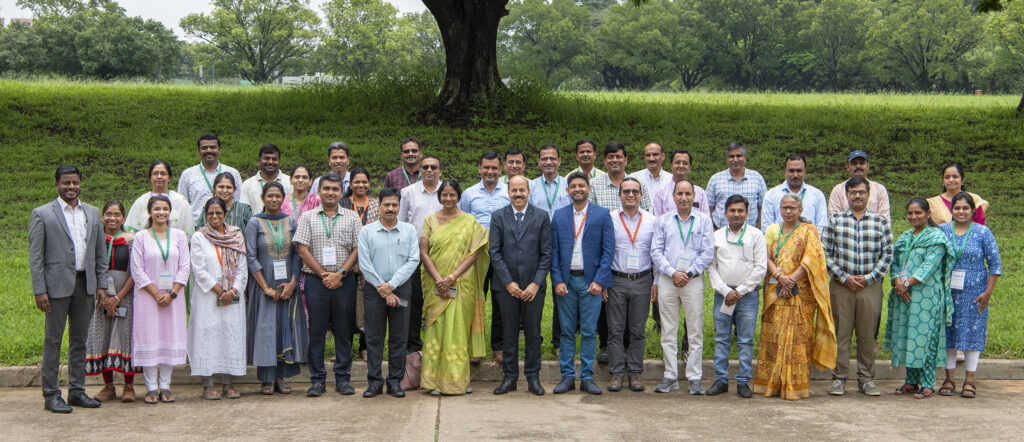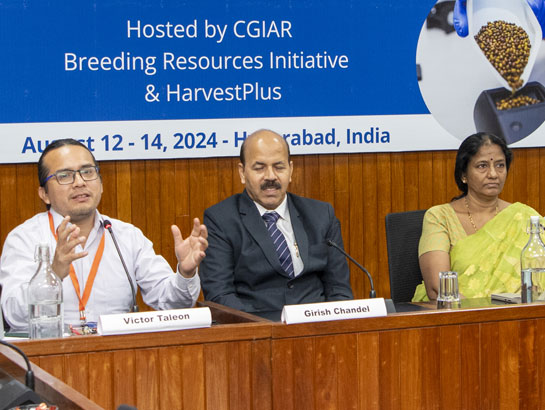HarvestPlus and the CGIAR Breeding and Research Service (BRS) hosted a three-day workshop on Elemental Analyses Services from August 12 to 14, 2024, at the International Crops Research Institute for the Semi-Arid Tropics (ICRISAT) station in Patancheru. This event brought together 43 participants from key stakeholders to explore and advance the science of elemental analysis in crop breeding, with a particular focus on nutrition traits. The participants represented 22 National Agricultural Research Systems (NARS) – 15 CGIAR, three private seed companies, three service provider members, and 10 crop groups.
The workshop featured a series of insightful presentations. Arun Baral, CEO of HarvestPlus, highlighted the organization’s pioneering work in X-ray fluorescent (XRF) spectrometry and Near-infrared spectroscopy (NIRS) for mineral and vitamin traits. This innovation, supported by BRS, is crucial for fast-tracking product screening and testing, providing a significant boost to global biofortification efforts. Erick Boy, the Chief Nutritionist at HarvestPlus emphasized the advancements in crop development and nutrition efficacy, showcasing the organization’s ongoing contributions to this field.

Eng Hwa Ng (BRS co lead) and Rajaguru Bohar (regional coordinator) provided an overview of BRS and global shared services, explaining how BRS is expanding its offerings to include nutrition traits phenotyping. This expansion is being facilitated through strategic agreements between HarvestPlus and BRS for XRF services, and with ICRISAT for NIRS services. This collaboration is central to enhancing the testing and screening of nutritional traits across various CGIAR centers, leveraging HarvestPlus’ expertise.
The workshop also addressed the importance of micronutrient traits in breeding programs, with Tara Satyavathi director of the Indian Council of Agricultural Research- Indian Institute of Millets Research (ICAR-IIMR) discussing ongoing improvements in iron and zinc levels in pearl millet. M Govindaraj (Senior Scientist, Crop Development) emphasized XRF lab facilities, services available with crops standards. The strategic importance of HarvestPlus coordinated laboratory facilities, particularly in India, Rwanda, and Bangladesh—where more than 40,000 samples are analyzed annually—was also underscored.
Dr Girish Chandel -vice chancellor of Indira Gandhi Agricultural University, emphasized the group on the improvements of breeding pipelines for these micronutrients which requires additional investment to keep the biofortification mainstreaming forward. CGIAR market segment and target product profile explained by Dr. Matty Demont, lead of Market Intelligence and Product Profiling Initiative (MIPPI) of genetic innovation (GloMIP). The GloMIP dashboard was highlighted to identify potential crops for breeding micronutrient, vitamin, and other nutritional traits, regardless of market segment, specific to geographic regions.
A key outcome of the workshop was the agreement to conduct an inter-laboratory proficiency test for XRF and NIRS in 2025. This initiative, coordinated by HarvestPlus, aims to validate and improve laboratory accuracy and efficiency across the region under BRS support and collaboration.
The event concluded with the formation of crop-specific teams, each led by a designated focal point, to map trait donors and document databases. This collaboration marks a significant step forward in the standardization and capacity building of nutrition screening across South Asia, with BRS and HarvestPlus playing a central role in driving these advancements – enabling mainstreaming nutrition in crop breeding programs.
